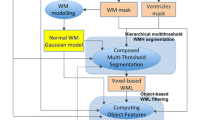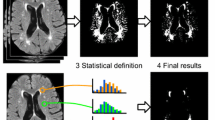Abstract
Quantitative analysis of the changes to the brain’s white matter is an important objective for a better understanding of pathological changes in various forms of degenerative brain diseases. To achieve an accurate quantification, an algorithm is proposed for automatic segmentation of white matter atrophies and lesions from T1-weighted 3D Magnetic Resonance (MR) images of the head. Firstly, white matter, gray matter and cerebrospinal fluid (CSF) compartments are segmented. Then, external and internal cisterns are separated by placing cutting planes relative to the position of the anterior and posterior commissure. Finally, a region growing method is applied to detect lesions inside the white matter. Since lesions may be adjacent to the gray matter, we use the external cisterns as a clue to prevent the algorithm from absorbing low gray level points in the gray matter.
The method is fully applied to detect the white matter lesions and relevant structures from a set of 41 MR images of normal and pathological subjects. Subjective assessment of the results demonstrates a high performance and reliability of this method.
Chapter PDF
Similar content being viewed by others
Keywords
These keywords were added by machine and not by the authors. This process is experimental and the keywords may be updated as the learning algorithm improves.
References
Atkins, M.S., Mackiewich, B.T.: Fully automatic segmentation of the brain in mri. IEEE Trans. Med. Imag. 17(1), 98–107 (1998)
Bezdek, J.C., Hall, L.O., Clarke, L.P.: Review of mr image segmentation techniques using pattern recognition. Med. Phys. 20(4), 1033–1048 (1993)
Clarke, L.P., Velthuizen, R.P., Camacho, M.A., Heine, J.J., Vaidyanathan, M., Hall, L.O., Thatcher, R.W., Silbiger, M.L.: Mri segmentation: Methods and applications. Magn. Reson. Imag. 13(3), 343–368 (1995)
Rajapakse, J.C., Kruggel, F.: Segmentation of mr images with intensity inhomogeneities. Image and Vision Computing 16, 165–180 (1998)
Pachai, C., Zhu, Y.M., Grimaud, J., Hermier, M., Dromigny-Badin, A., Boudraa, A., Gimenez, G., Confavreux, C., Froment, J.C.: A pyramidal approach for automatic segmentation of multiple sclerosis lesions in brain mri. Computerized Med. Imag. and Graph 22, 399–408 (1998)
Johnston, B., Atkins, M.S.: Segmentation of multiple sclerosis lesions in intensity corrected multispectral mri. IEEE Trans. Med. Imag. 15(2), 154–167 (1996)
Udupa, B., Wei, S., Samarasekera, L., Miki, Y., Van Bucchem, M.A.: Multiple sclerosis lesion quantification using fuzzy-connectness principles. IEEE: Trans on Med. Imag. 16(5), 598–609 (1997)
Kamber, M., Shinghal, R., Collins, L., Francis, G.S., Evans, A.C.: Model based 3- d segmentation of multiple sclerosis lesions in magnetic resonance brain images. IEEE Trans. Med. Imag. 14(3), 442–453 (1995)
Haralik, R.M., Shapiro, L.G.: Survey: Image segmentation techniques. Comput. Vision, Graphics, Image Processing 29, 100–132 (1985)
Pal, N.R., Pal, S.K.: A review on image segmentation techniques. Pattern Recognition 26, 1277–1294 (1993)
Hojjatoleslami, S.A., Kittler, J.: Region growing: A new approach. IEEE Trans Image Proc 7(7), 1079–1084 (1998)
Hojjatoleslami, S.A., Kruggel, F., von Cramon, D.Y.: A region based algorithm for brain segmentation in mri, submitted (1999)
Serra, J.: Image analysis and mathematical morphology: theoretical advances, vol. 2. Academic Press, New York (1988)
Author information
Authors and Affiliations
Editor information
Editors and Affiliations
Rights and permissions
Copyright information
© 1999 Springer-Verlag Berlin Heidelberg
About this paper
Cite this paper
Hojjatoleslami, S.A., Kruggel, F., von Cramon, D.Y. (1999). Segmentation of White Matter Lesions from Volumetric MR Images. In: Taylor, C., Colchester, A. (eds) Medical Image Computing and Computer-Assisted Intervention – MICCAI’99. MICCAI 1999. Lecture Notes in Computer Science, vol 1679. Springer, Berlin, Heidelberg. https://doi.org/10.1007/10704282_6
Download citation
DOI: https://doi.org/10.1007/10704282_6
Publisher Name: Springer, Berlin, Heidelberg
Print ISBN: 978-3-540-66503-8
Online ISBN: 978-3-540-48232-1
eBook Packages: Springer Book Archive




